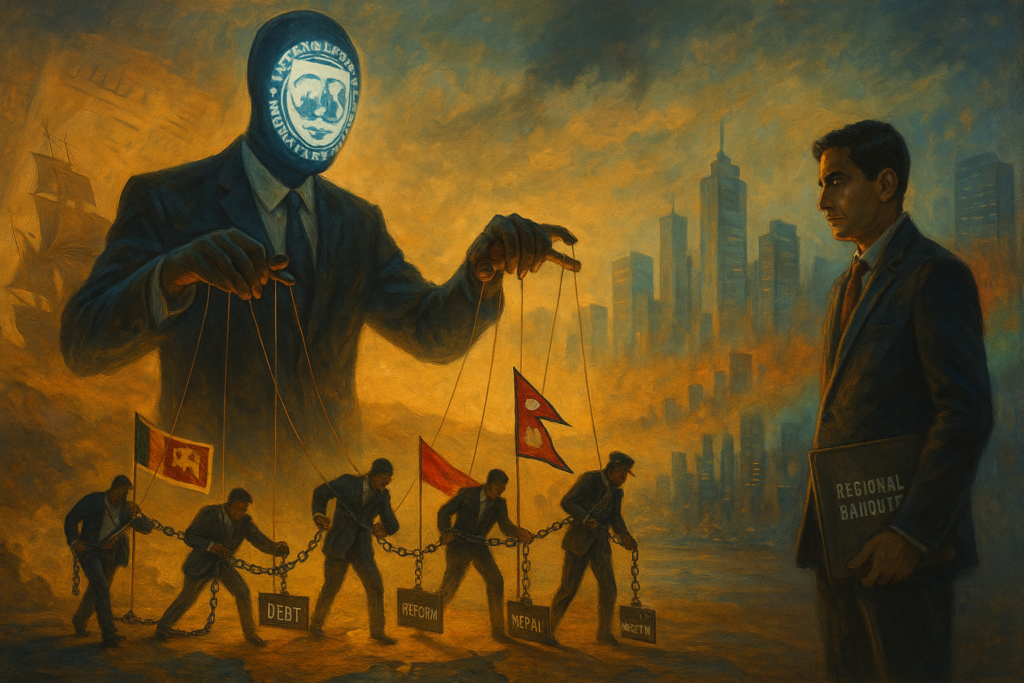
- The IMF was established to promote global stability; nonetheless, its lending methods have trapped developing countries in cycles of dependency, notably in South Asia.
- IMF’s policies follow a neocolonial model in which borrower states hand over policy autonomy to Western-dominated organisations, similar to the East India Company’s subsidiary alliances that drained India’s resources.
- For India, Sri Lanka’s rescue presents a conflict: as a key creditor giving $4 billion in aid, Delhi favours stability to counter Beijing’s port footholds, yet IMF conditions risk drawing the region into a US-led orbit, evoking EIC-era spheres of influence.
- By the next decade, South Asia could be divided between those constrained by IMF conditions and those anchored by India-led regional finance.
In the annals of economic imperialism, the British East India Company is an infamous icon of exploitation, where trade became territory domination and sovereignty was exchanged for loans and concessions. Fast forward to the twenty-first century, and the International Monetary Fund (IMF) emerges as its modern incarnation, using financial leverage to impose policies reminiscent of colonial-era tactics. The IMF, which emerged from the Bretton Woods system in 1944, was established to promote global stability; nonetheless, its lending methods have trapped developing countries in cycles of dependency, notably in South Asia.[1]
Just as the Company used monopolistic trade, harsh tariffs, and political interference to subjugate India, the IMF’s bailouts now include austerity measures, structural reforms, and conditionalities that perpetuate dependency, stifle sovereignty, and serve Western geopolitical interests. The question is, when does financial rescue turn into political control? How is India caught in the crossfire?
The IMF’s Playbook: Debt as a Tool of Control
The IMF’s Extended Fund Facility (EFF) and other comparable programs offer short-term respite but require broad reforms that prioritise fiscal discipline over social welfare. These conditions, which range from subsidy cuts and privatisation to tight monetary policies which frequently aggravate inequality and impede growth in fragile economies.[2] Such policies follow a neocolonial model in which borrower states hand over policy autonomy to Western-dominated organisations, similar to the East India Company’s subsidiary alliances that drained India’s resources.
In South Asia, where colonial legacies still exist in weak economies, IMF loans have consistently failed to address core reasons such as corruption and external shocks, sustaining a borrowing cycle. For example, the Fund’s emphasis on eliminating subsidies on essentials like fuel and fertiliser disproportionately affects the poor, and structural reforms benefit international firms over local industries.[3] This asymmetry is stark: the United States wields veto power with a 16.5% voting share, while emerging nations like India have only a fraction, ensuring that conditions are aligned with global capital interests rather than regional realities.[4]
Case Studies: IMF’s Grip on South Asia’s Fragile Economies
Pakistan’s experience with the IMF demonstrates the dangers of the debt trap, as the country has approached the Fund 24 times since 1958, including four programs in the previous five years alone.[5] In September 2024, Islamabad received a $7 billion EFF,[6] with the first review in May 2025, freeing $1 billion amid claims of economic stabilisation.[7] However, tensions escalated in October 2025 when the IMF walked out of talks without signing a Staff-Level Agreement, preventing the release of another $1 billion tranche due to unfulfilled fiscal deficit and reserve requirements.[8] Conditionalities included reducing subsidies, raising energy rates, and reorganising state-owned firms, all of which exacerbated popular unrest and inflation, reminiscent of the 1970s oil shocks that initially brought Pakistan into the IMF’s circle.[9]
In May 2025, New Delhi refrained from voting on the bailout, expressing concerns about monies being diverted to “state-sponsored cross-border terrorism” and Pakistan’s dismal reform record. Despite India’s protests, the IMF approved an additional $1.4 billion under the Resilience and Sustainability Facility for climate resilience, disregarding Delhi’s request for a full audit.[10] The Fund’s leniency, waiving noncompliance with criteria does demonstrates its selective enforcement, which prioritises geopolitical stability over accountability, similar to the EIC’s protection of British commercial interests at India’s expense.
Sri Lanka’s 2022 economic disaster, caused by debt overload and policy mistakes, was the country’s worst crisis since independence, with inflation reaching 70% and GDP dropping 7.3%. The IMF’s $3 billion EFF, granted in March 2023, came with strict conditions, including debt restructuring, tax increases, and utility price liberalisation, which caused widespread protests.[11]
By February 2025, the third assessment had disbursed $334 million, recognising budgetary surpluses but highlighting delays in anti-corruption targets.[12]
In Pakistan's case, repeated IMF bailouts, harsh conditionalities, and selective leniency reveal how financial rescue can morph into political control serving Western interests.
Progress intensified in 2025, with 4.8% GDP growth in the first half and reserves reaching $6.1 billion by September,[13] but at the expense of social spending cuts that increased inequality. The fifth review staff-level agreement in October 2025 freed $347 million,[14] subject to legislative approval of the 2026 budget and the completion of $25 billion in debt restructurings with creditors such as India and China. India’s $4 billion bailout in 2022-23 prevented an immediate collapse, but IMF rules now require debt restructuring with China, its largest creditor.[15]
For India, Sri Lanka’s rescue presents a conflict: as a key creditor giving $4 billion in aid, Delhi favours stability to counter Beijing’s port footholds, yet IMF conditions risk drawing the region into a US-led orbit, evoking EIC-era spheres of influence.
Bangladesh’s $4.7 billion ECF/EFF/RSF in January 2023 was “precautionary,” buffering shocks from the Ukraine war, which eroded reserves.[16] The 2024 rebellion deposed the Awami League administration, ushering in an interim regime dealing with inflation and banking difficulties.[17] The second tranche of $689 million arrived in January 2025,[18] followed by $1.3 billion in June for the third and fourth reviews,[19] which included exchange rate waivers and an extension to address financial deficiencies. Bangladesh accepts softer conditions, such as bank reforms, increased transparency, inflation management, and the possibility of rising fuel or energy rates, but with less disruption than Pakistan or Sri Lanka. Still, there is a risk: once conditions are imposed, political backlash tends to escalate.[20]
India’s Precarious Balancing Act
India, as South Asia’s dominant power centre, is caught in a dilemma. On the one hand, the collapse of Pakistan or Sri Lanka poses a direct risk to the neighbourhood: mass migration, instability, radicalism, and policy vacuums that draw extra-regional powers (China, the Gulf, and even Western actors). India’s “NNeighbourhoodFirst” policy requires backing for distressed friends to prevent turmoil from spreading, but IMF loans impose Western conditions that contradict New Delhi’s vision of a multipolar Asia.
In Pakistan’s instance, India’s strong complaints in 2025, abstention from voting and calls for reviews highlighted concerns over terror financing, but criticisms are symbolic due to minimal board influence (as one of 25 constituencies). New Delhi has supplied bilateral aid worth more than $6 billion to Sri Lanka and Bangladesh since 2022, but IMF programs marginalise India’s role by enforcing reforms that favour global lenders over regional solidarity.
The larger problem is that IMF conditions fit with Western goals—limiting China’s Belt and Road influence (e.g., Sri Lanka’s debt talks)—but at India’s cost. Reforms expected of neighbours (fiscal restraint, SOE privatisation) echo 1991’s liberalisation, which boosted India’s GDP, but they risk importing a fiscal epidemic.
India's "Neighbourhood First" policy requires backing for distressed friends to prevent turmoil from spreading, but IMF loans impose Western conditions that contradict New Delhi's vision of a multipolar Asia.
This dynamic is reminiscent of the East India Company era: just as Britain previously separated princely states, the IMF exacerbates South Asian schisms by connecting funding to liberalisation that benefits Western capital. PM Modi’s Atmanirbhar Bharat provides a self-reliance alternative, but regional turmoil from Pakistan’s instability to Bangladesh’s unrest tests India’s resolve. To counteract IMF expansion, India must improve SAARC structures and bilateral partnerships, or risk turning the region into a playground for foreign powers.[21]
By the next decade, South Asia could be divided between those constrained by IMF conditions and those anchored by India-led regional finance. India’s objective will be to stabilise its neighbours without becoming their funder. If it establishes reliable regional credit systems, it may replace external lenders as the region’s anchor.
References:
- [1]The Case against the International Monetary Fund
- [2] The damage of International Monetary Fund ‘conditionality’: call for urgent rethink
- [3] The Fund’s 2023 Fossil Fuel Subsidies Update
- [4]IMF Official: Members’ Quotas and Voting Power (Updated 2025)
- [5] Will the IMF’s $7 Billion Bailout Stabilize Pakistan’s Economy?
- [6] Is Pakistan’s $7bn IMF bailout package in trouble?
- [7] Explained: Why IMF gave Pakistan $1 billion despite India’s objections
- [8] IMF walks out without signing Pakistan SLA, $1 billion loan tranche on hold
- [9] Pakistan and the IMF: A Cycle of Dependency and the Need for Genuine Reform
- [10] India abstains from IMF vote on Pakistan aid, cites terror concerns, loan misuse
- [11] IMF Executive Board Approves US$3 Billion Under the New Extended Fund Facility (EFF) Arrangement for Sri Lanka
- [12] IMF Executive Board Completes the Third Review Under the Extended Fund Facility Arrangement with Sri Lanka
- [13] Sri Lanka GDP grows 4.8-pct in the first quarter 2025
- [14]IMF, Sri Lanka Reach 5th Review Staff Agreement
- [15] Sri Lanka gets fourth tranche of bailout package from IMF
- [16] IMF Executive Board Approves US$3.3 Billion Under the Extended Credit Facility/Extended Fund Facility and US$1.4 Billion Under the Resilience and Sustainability Facility for Bangladesh
- [17] Bangladesh bans activities of deposed PM Sheikh Hasina’s Awami League party
- [18] IMF approves $689m loan for Bangladesh with advice to contain inflation
- [19] IMF says Bangladesh to receive $1.3 billion under third and fourth reviewliberalisations
- [20] IMF tightens pressure on Bangladesh
- [21] India needs to act as a facilitator in reviving SAARC
Pranav S is a Project Assistant at the Energy Department, Government of Karnataka with an MA in Public Policy. Views expressed are the author’s own.
